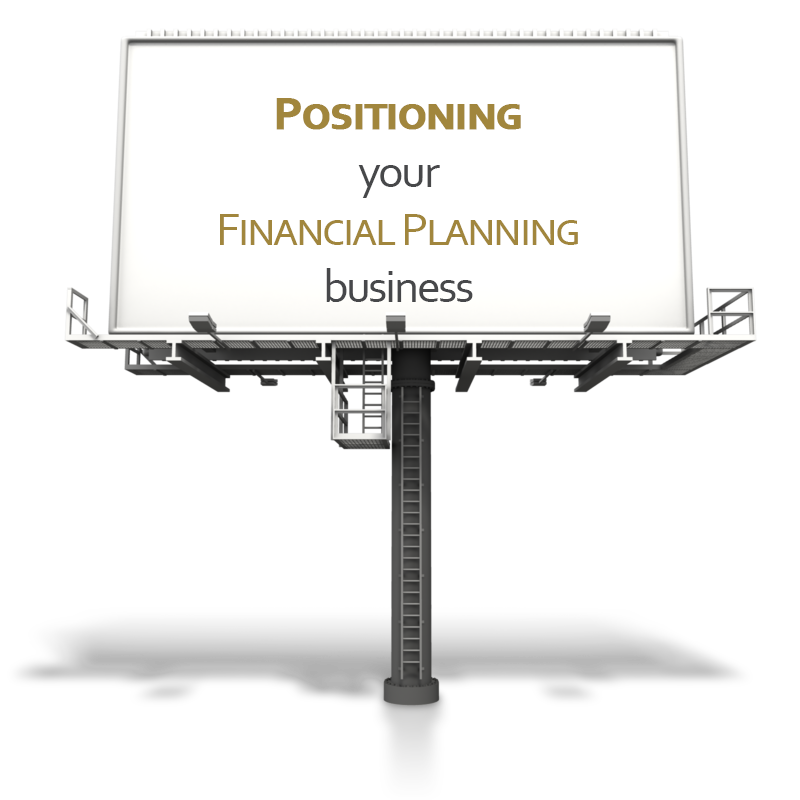 Product positioning is a concept that is well known in marketing circles. A product positioning strategy is all about trying to create an identity in the minds of your target market. This identity can be at a business or brand level, or at a product or service level.
Product positioning is a concept that is well known in marketing circles. A product positioning strategy is all about trying to create an identity in the minds of your target market. This identity can be at a business or brand level, or at a product or service level.
So when your target market hears about your financial planning business, what do they think about? Do they see your brand in the same way that you see it?
It’s all about them
When clients think about your business, they’re thinking about it in terms of what it can do (or has done) for them. It’s all about them. So the first lesson here is that your marketing messages have to be speaking the same language as the client. If your marketing messages don’t demonstrate the benefits to the client, or they’re communicated in a way that doesn’t demonstrate the benefits to the client, you’re missing the mark.
What is your core message?
When I think about successful financial advisory businesses, they have one core marketing message of position that they use with their clients. They know that if they make it too complicated, the clients won’t remember anything. Keeping it simple is the key.
There are a few things your key message has to consider:
- Who is the message aimed at. In other words, who is your target market?
- What are their issues? What are the problems that face your target market when it comes to their personal finances. And, importantly, what solutions can you provide to help them?
- What are the benefits to the client? What’s in it for them? Can you clearly articulate how your product or service helps to solve their problems. Can can you communicate this in a way that’s easily understandable?
- What makes you different? I’m a big believer in differentiating your business from others. Most planners think they do things differently, but they really don’t. Don’t say you offer personalised service – everyone does that! Create something that no-one else does, name it and make sure your clients realise that you are the only person who can supply it.
Let’s go into some more detail on each of these four areas.
[pwal id=”27272233″ description=”There’s lots more of this article to read. Please click on one of the social media buttons below to share this post. Once you’ve shared it, you’ll get access to the full post.”]
Target Market
It helps to have a clear picture of who your ideal clients are. How old are they, where do they live, what is their occupation, do they have families etc?
Think about some of your existing clients and write down some of these factors. Build up a profile of what your ideal client looks like.
I’ve heard some instances where businesses actually create a pretend client who fits their ideal profile – they name the client and do all they can to make it appear as real to them as possible. Then, when they’re creating any marketing, they think about how their pretend client would respond to this marketing message.
Also think about some of the characteristics of your target market. Do they spend lots of money or prefer to save it? Do they like travelling or staying home? Are they conservative people?
Once you have a clear focus on who you’re targeting, you can move on to the next step.
What are their issues and what is your solution?
Think about the problems that face your target market. What keeps them awake at night? What worries them when it comes to money?
If you’ve already got clients who fit your target client profile you probably already know the answers to some of these questions. But don’t assume anything – ask the questions. Call those clients up, explain you’re planning some future marketing to get more people like them as clients and ask them to help you better understand the things that worry them.
You need to get as specific as possible about the problems these people face.
Once you know the problems, you can begin to communicate your solutions. What do you provide that can fix their problem? And how can you explain this so it’s instantly understood by a prospect?
Communicate the benefits
Your clients don’t care about what your solution is, they’re only concerned with what it does – the benefits to them.
The mistake that a lot of financial planners make is that we want to explain everything to clients, but most of them don’t care. They just want to know how our solutions will take their pain away.
Learn how to communicate the benefits of what you do. Talk about how your strategies will increase their cash flow, reduce their tax, boost their retirement savings etc. Also don’t forget the non-financial benefits such as peace of mind and being able to sleep at night. These things are important to your clients.
Be different
Finally, understand what makes you different from your competitors. This is the last piece to the positioning puzzle.
You must make the client understand what it is that you do that is unique to you. Is it in the way you deliver your service, is it in the products you use or the strategies you recommend?
Whatever it is, make sure the prospect understands that this is something that only you can do for them.
